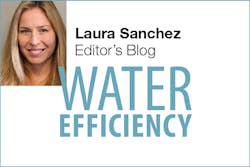It’s interesting to consider the origins of various units of measure. The acre, for example, once defined the area of land that a team of oxen could plow in a day. The Egyptian cubit, used in ancient architecture, represented the length of a man’s forearm, from the elbow to the tip of the middle finger. It became the basis for the British inch, foot, and yard.
Today water agencies in the western United States are reevaluating the relevance of the acre-foot, a unit of volumetric measure that may no longer accurately define consumers’ water needs.
For decades, the acre-foot has served as a standard volumetric used by water agencies to calculate demand. One acre-foot of water—325,000 gallons—was considered an adequate supply to fulfill the indoor and outdoor needs of two households for one year. But today consumers require less water, thanks to conservation programs, water-efficient technologies, and public awareness campaigns. Therefore, many water agencies in the west believe that this unit of measure should be reconsidered and a more precise one proposed.
As western states pare down water usage, some feel that the unit of measurement should decrease in parallel. Water usage in Nevada has dropped in the past decade. Today, an acre-foot is enough to supply two Las Vegas households for about 15 months. In Arizona, where conservation and reuse programs have reduced consumer usage significantly, an acre-foot is sufficient for three households. And California’s household water usage has decreased as well.
“Average residential water use varies widely throughout California, depending on factors such as housing density, landscaping, water rates, and when development occurred,” explains Gary Pitzer for Water Deeply. “Based on a sampling of 18 water agencies across California, the state estimated that in 2016, in the midst of the drought, an acre-foot was enough water to supply 3.4 households.”
As conservation programs and water efficiency technologies reduce the amount of water required by consumers, is it important to modify the standards of measurement? Should there be a smaller unit of measure to accurately define the amount of water one household? What do you think that the new unit of measurement should be based upon?
